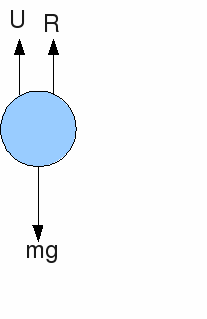When a body moves through a fluid it experiences a resistive force because the the presence of the fluid. Every fluid has a property called viscosity – the resistance of a fluid to any body moving through it. Thicker, more viscous materials resist more the movement of bodies through them than thinner, less viscous materials.
The viscosity of a material is described by it's coefficient of viscosity,![]() Under conditions of low velocity and non turbulent motion, the force experience by a sphere moving through a fluid is described by Stoke's Law:
Under conditions of low velocity and non turbulent motion, the force experience by a sphere moving through a fluid is described by Stoke's Law:
![]()
For this case, of a sphere moving through a fluid, a free body diagram is shown below.

On the diagram above, the upthrust U is equal to the weight of fluid displaced. If the density of the fluid is![]() and the density of the body is
and the density of the body is![]() the mass of fluid displaced is
the mass of fluid displaced is![]() and the weight of fluid displaced is
and the weight of fluid displaced is![]() and we can write the weight of the body similarly as
and we can write the weight of the body similarly as![]() If the body is travelling at it's terminal velocity all the forces balance and
If the body is travelling at it's terminal velocity all the forces balance and
![]()
If we know the viscosity, the terminal velocity![]() is given by
is given by![]()
If we measure the terminal velocity, the viscosity![]() is given by
is given by![]()
